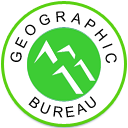
Elbrus expeditions. Trekking and ski-touring in the Mount Elbrus area. Caucasus Mountains, Russia. Mt Elbrus climb.
gb@geographicbureau.com phone: +7 812 230-45-76 Postal address: 197110, P.O. Box 162, St Petersburg, Russia








GLACIOLOGY AND HYDROLOGY
Areas above 3000m are heavily glaciated. The volcanic cone of Elbrus itself is covered by an ice cap of about 140 sq.km. 77 minor glaciers radiate from the Elbrus ice cap and some of them reach 400m in thickness. Among the most significant glaciers flowing from Elbrus are: Bolshoi (Greater) Azau (area 23 sq.km, 9.28 km long), Malyi (Small) Azau (8.49 sq.km, 7.58 km long), Garabashi (5 sq.km, 4.09km long), Terskol (7.56 sq.km, 7.02 km long), Irik (10.19 sq.km, 9.31 km long), Irikchat (1.79 sq.km, 2.67 km long). All the glaciers are in recession; during the last 100 years most have retreated between 80 and 500m. Glacier snouts reach down well below the snowline and give rise to numerous outfalls and rivers. Lakes are mostly of glacial origin, small in area but often deep.
There are many mineral springs, mainly in the upper Baksan, Irik, Adylsu and Malka valleys. Not far from Tegenekli village on the right bank of Baksan river, lies a glade of about 3 sq. km, surrounded by pine and birch wood, called Narzan Glade after its very high quality mineral springs. These are the most accessible of mineral springs in the area.

